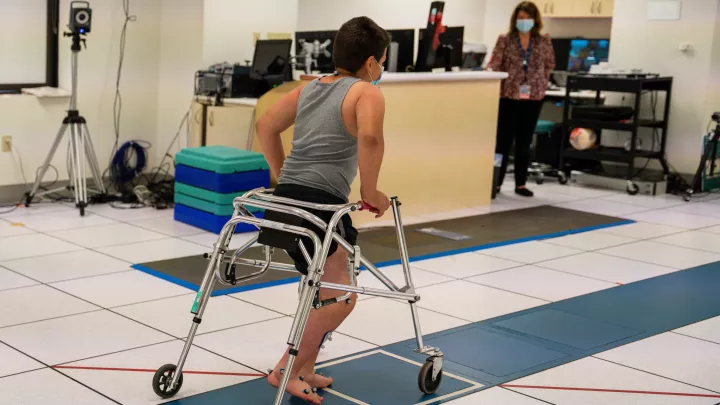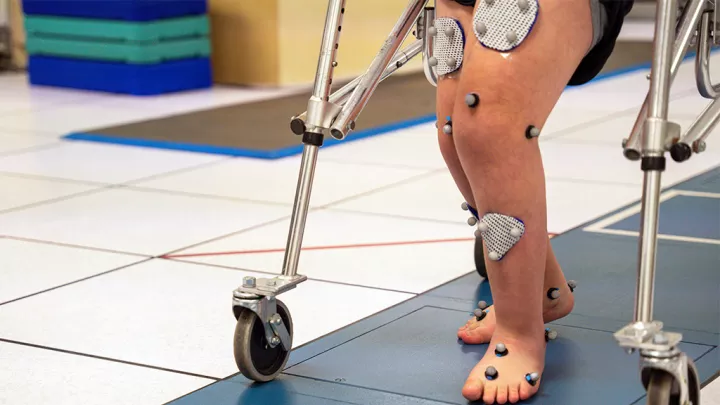
Biomechanics Study Aims to Help Prevent Youth Sports Injuries
Many studies have aimed to better understand the kinds of injuries that occur during youth sports. But there’s been relatively little research to address the most pressing issue: How can these injuries be prevented?
To help answer that question, investigators at Children’s Hospital Los Angeles are using state-of-the-art computerized 3D motion analysis to study healthy, never-injured youth athletes. The goal is to see if particular athletic movement patterns—as well as factors like sleep—can help predict a child’s risk of sports injury.

The team presented early data from this project at the American Medical Society for Sports Medicine (AMSSM) Annual Meeting, held April 28-May 3 in Phoenix. The study showed that teen athletes demonstrated better overall sports biomechanics than their preteen peers—particularly when performing a single-leg hop.
“The single-leg hop was the movement that elicited the biggest differences between these two groups,” says Tishya Wren, PhD, Director of Research for the Jackie and Gene Autry Orthopedic Center and senior author of the study. “If younger athletes have a biomechanical deficiency, it will likely show up when they’re performing this task.”
Testing athletic skills
In the study, 84 uninjured youth athletes underwent 3D motion analysis testing focused on the lower extremities. The testing took place at the John C. Wilson Jr. Motion and Sports Analysis Lab at CHLA—one of the busiest and most experienced labs of its kind in the country.
The athletes included 45 preteens ages 8 to 12, and 39 teens ages 13 to 18, with all participating in sports at least three times a week. Participants completed a series of six athletic skills: heel touch, drop jump, lateral shuffle, deceleration, sidestep cut and the single-leg hop.
These maneuvers were recorded by the 10-camera motion capture system in the Motion and Sports Analysis Lab. Force plates embedded in the floor measured motion kinetics, while multiple sensors precisely tracked joint movements.
Based on this 3D analysis, each limb was scored for hip, pelvic and trunk stability, as well as for shock absorption and hip strategy. The team found that scores for shock absorption, hip strategy and the single-leg hop—as well as total biomechanics scores—were significantly worse in the preteen group compared with the teens.

“It’s not surprising to see that teens have better biomechanics because their limb and muscle control is more developed,” notes Ryan Kelln, DO, FAAP, a primary care sports medicine specialist at Children’s Hospital Los Angeles and first author of the study. “What’s exciting for me is that the single-leg hop may be a specific skill that could help identify which young athletes have weaker biomechanics.”
For example, pediatricians could ask patients during a sports physical evaluation to do a single-leg hop as a simple screen to identify youth who may have weaker lower extremity biomechanics. This weakness could then be addressed prior to that patient participating in activities that could put them at higher risk for injury, Dr. Kelln says. In addition, coaches and PE teachers could focus on developing this skill in young students to reduce their injury risk.
Next steps
Enrollment for the study is ongoing. After the initial biomechanical assessment, the team follows participants with a weekly email survey for the first year, and with an annual survey for three years.
Researchers are collecting data from the athletes on which sports they play, number of hours spent on athletics, the age when they began participating in sports, any injuries they sustain and how much they sleep each night.
Over time, the team will be investigating how factors like sleep, gender assigned at birth and playing multiple sports impact rates of injury. Researchers will also be able to see if those who scored lower in their initial biomechanics tests have higher rates of injuries later on.
“As we break down this data further, we will be able to get a better understanding of some of these risk factors,” Dr. Kelln says. “The more we can prevent youth sports injuries, the more we can keep kids out on the field, doing what they love.”
Study authors were Ryan Kelln, Sarah N. Adams, Mia J. Katzel and Tishya A. L. Wren. Dr. Kelln presented the results at the AMSSM meeting.


